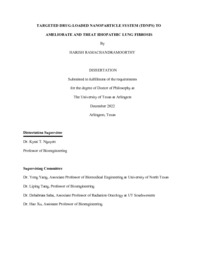
ATTENTION: The works hosted here are being migrated to a new repository that will consolidate resources, improve discoverability, and better show UTA's research impact on the global community. We will update authors as the migration progresses. Please see MavMatrix for more information.
Show simple item record
| dc.contributor.advisor | Nguyen, Kytai T | |
| dc.creator | Ramachandramoorthy, Harish | |
| dc.date.accessioned | 2023-06-28T00:04:37Z | |
| dc.date.available | 2023-06-28T00:04:37Z | |
| dc.date.created | 2022-12 | |
| dc.date.issued | 2022-12-19 | |
| dc.date.submitted | December 2022 | |
| dc.identifier.uri | http://hdl.handle.net/10106/31354 | |
| dc.description.abstract | Idiopathic pulmonary fibrosis (IPF) is a fatal progressive disease with a dismal prognosis and 3-5 years of survival. Up to date, there are no effective treatments, and a few current therapies that do not ameliorate the pulmonary fibrosis but rather just increase the survival time by 2-3 years. The major factor limiting the treatment is the lack of targeted therapies to deliver the drugs past the mucosa, into the disease microenvironment. To combat this disease, we proposed a localized therapy via our targeted drug-loaded nanoparticles (TDNPs) to effectively deliver drugs and treat lung fibrosis. Our objective was to design TDNPs that should pass the thick mucus layer and release potent drugs at the lung fibrosis tissue in a controlled manner. Our designed TDNPs are comprised of an FDA approved drug Pirfenidone that inhibits the pro-fibrotic cytokines. Furthermore, the TDNP is tagged with antibodies against Fibroblast Activation Protein (FAP), which is overexpressed in the diseased tissue so that the targeting and retention of the nanoparticle at the fibrosis site could be enhanced. We also developed a novel lung fibrosis-on-chip platform to evaluate the effectiveness of the TDNP modality with highest precision surpassing the drawbacks of conventional therapeutic efficiency testing. Three specific aims followed are: 1) To design and characterize TDNPs for treating lung fibrosis, 2) To determine the therapeutic efficiency of TDNPs through 2-D and 3-D based in vitro studies, and 3) To evaluate the therapeutic effectiveness of our designed NPs using lung fibrosis animal models. The TDNPs were successfully fabricated with a size <500nm that was optimal for deep alveolar delivery. The NPs had sustained release of drugs up to 3 days and high stability for the same time period. We also demonstrated that the NPs, due to their PEGylated surface, were able to penetrate the mucus layer and the collagen matrix layer that mimic the in vivo conditions significantly higher than that of the PLGA NPs. TDNPs showed more than a 2-fold increase in uptake and accumulation in fibrotic cells significantly higher than that of non-targeted NPs showing the effectiveness of FAP targeting. The NPs also displayed significantly higher therapeutic efficiency by reducing the expression level of αSMA by around 5 & 7-fold in 2D and 3D fibrosis models, respectively compared to that of the free drug. The TDNPs were also able to localize and retain significantly more in the lung tissue compared to the PLGA NPs. We have thus showed that the synthesized TDNPs would serve as a functional drug delivery system that can pass the pulmonary barriers and deliver drugs to the injured lung tissue to treat pulmonary fibrosis. | |
| dc.format.mimetype | application/pdf | |
| dc.language.iso | en_US | |
| dc.subject | Nanoparticles | |
| dc.subject | Mucus penetrating | |
| dc.title | TARGETED DRUG-LOADED NANOPARTICLE SYSTEM (TDNPS) TO AMELIORATE AND TREAT IDIOPATHIC LUNG FIBROSIS | |
| dc.type | Thesis | |
| dc.date.updated | 2023-06-28T00:04:37Z | |
| thesis.degree.department | Bioengineering | |
| thesis.degree.grantor | The University of Texas at Arlington | |
| thesis.degree.level | Doctoral | |
| thesis.degree.name | Doctor of Philosophy in Biomedical Engineering | |
| dc.type.material | text | |
| dc.creator.orcid | 0000-0002-3431-365X | |
Files in this item
- Name:
- RAMACHANDRAMOORTHY-DISSERTATIO ...
- Size:
- 3.140Mb
- Format:
- PDF
This item appears in the following Collection(s)
Show simple item record


